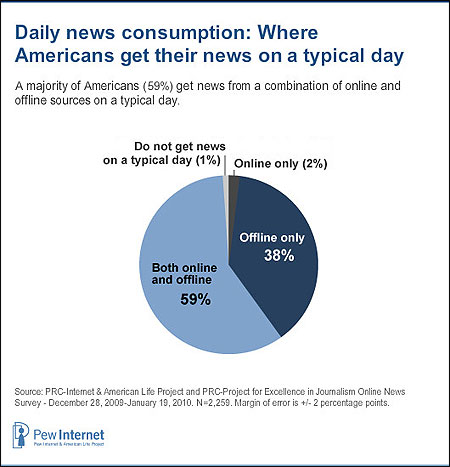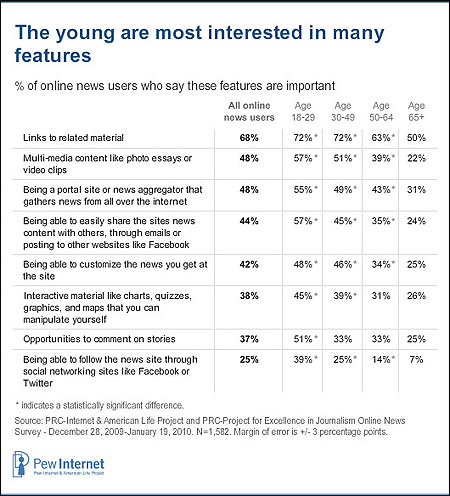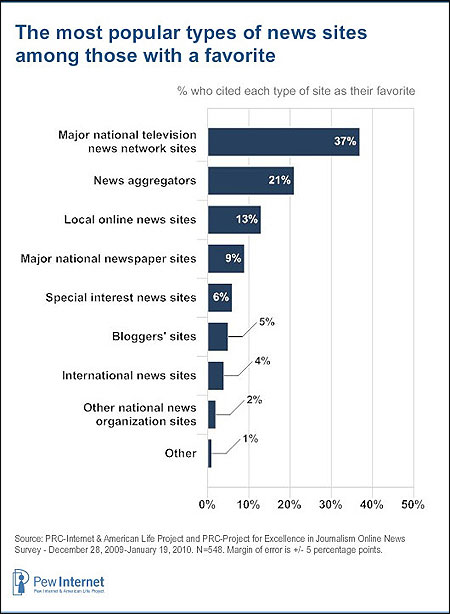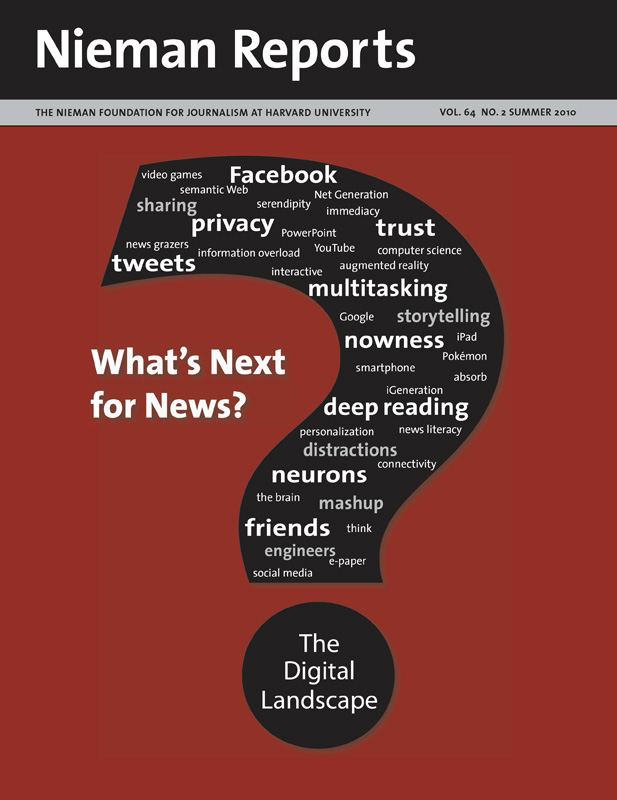
A major survey released in March looked at Americans’ changing news habits. Courtesy of Pew Research Center’s Project for Excellence in Journalism and the center’s Internet & American Life Project.
The Internet and cell phones are changing people’s relationship to news—when, how and where they consume it. The emerging digital devices also dramatically alter how journalists gather the news and what happens to their reporting after it appears.
Just how much all of this is changing—and what it means to Americans’ news habits—is revealed in a joint survey released in March by the Pew Research Center’s Project for Excellence in Journalism and the center’s Internet & American Life Project. Here are some of its findings:
- On a typical day, 61 percent of Americans get news online. This means that the Internet is now just behind television as a news source and ahead of newspapers.
- Thirty-seven percent of adults now access the Internet on their cell phones and PDAs.
- Digital news consumers tend to be younger than the general population—68 percent are under 50 and 29 percent are under 30. But the movement toward online news is evident in all age groups.
Technology is fueling these developments as it reshapes in profound ways the news ecosystem. Social media tools and mobile connectivity provide citizens with a deeper and more direct relationship with the news. Consumers search and filter, then react to and share news they find interesting or vital with followers and friends. This is especially true among the young, whose social networks often become personal “editors” who determine their front page information.
Two surveys of teens and adults released early this year by the Pew Internet Project found that nearly three-quarters of 12- to 17-year-olds who are online and an almost equal number of young adults (ages 18 to 29) use social network sites. In contrast, 40 percent of those who are over the age of 30 used social networking sites in the fall of 2009. (These findings emerge as part of a yearlong Pew initiative to develop a portrait of “generation next.”)
Grazing With News
In this digital media environment, Americans have become news grazers but not aimless wanderers.
Most people are comfortable using a number of platforms for their news. On a typical day, according to our surveys, nearly half of Americans are drawn to news stories on four to six platforms, including online, TV and print. Most also turn to multiple sources within those platforms. Only 21 percent tell us that they tend to rely primarily on one destination; when asked if they have a favorite online news source, a surprisingly small segment of online news users (35 percent) say they did. These users are the most active in consuming news online—individuals who explore the greatest variety of topics online and use the greatest number of online sources.
Still, we found that online news grazers do not stray far. Fifty-seven percent rely mostly on two to five Web sites. Only 12 percent use more than six. They also turn to the Web for a wide variety of news topics. In our survey we questioned participants about 12 topics. Forty percent said they explored at least nine of them, with weather and national events being the most popular.
For now, legacy-based Web sites get most of the online news audience. The 35 percent with a favorite news site most often named Web sites of major national television news organizations such as CNN and Fox News. In a separate analysis that the Project on Excellence in Journalism conducted this year using Nielsen’s NetView database of online audience measurements, we found that Web sites tied to legacy news organizations like newspapers or cable stations attract 67 percent of the news traffic.
Yet there is evidence that this dominance could change. The next favorite kind of news site among those who have a favorite is a news aggregator such as Yahoo! News, Topix and GoogleNews. And when asked what sources people use on a typical day (not just their favorite site), portals top the list with more than half of those surveyed visiting daily. Among 18- to 29-year-olds, 68 percent typically access news aggregators for their news, and there are signs that they often go no further, deciding that all they need is the headline, byline and first sentence of text.
The implications of such emerging habits for both the content and financial strategies of those who report news and convey information are extraordinary. And mobile devices are adding yet another significant platform for audiences and bringing new information sources into the mix. Our survey illuminated this trend with a variety of responses:
- Twenty-six percent of Americans say they get some form of news today via a cell phone. That amounts to 33 percent of cell phone owners. (About 80 percent of American adults have cell phones.)
- There is every reason to think this number will rise significantly as more and more people get smartphones, such as the iPhone and those with Google’s Android and Microsoft’s Windows Mobile operating systems on them.
- In the topics mobile phone users seek out, weather again takes the lead, but news and information about current events comes in second.

The young are more interested than older Internet users in commenting on and sharing news stories, according to the survey results above. Many online news consumers favor the sites of the major television news networks, as is shown below. Charts courtesy of Pew Research Center’s Project for Excellence in Journalism and the center’s Internet & American Life Project.

Keeping an Eye on Readers’ Habits
When it comes to figuring out who the new news consumers will be and where they will land, the Web is showing itself to be a place where visitors don’t linger at any one place for very long. The in-depth examination of Nielsen’s data shows that the average visitor to the top 199 news Web sites stopped there for only three minutes and four seconds per session. This represents a fraction of the time that readers, on average, have spent with a print newspaper; in the Northwestern University Readership Institute’s 2008 study that examined newspaper and online reading habits in 100 U.S. communities, people who read newspapers said that they spent an average of 27 minutes doing so on weekdays and 57 minutes on Sunday.
Amy Mitchell is deputy director of the Pew Research Center’s Project for Excellence in Journalism.



